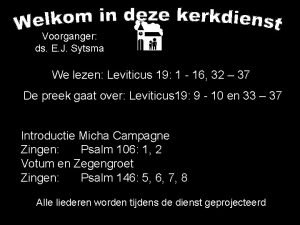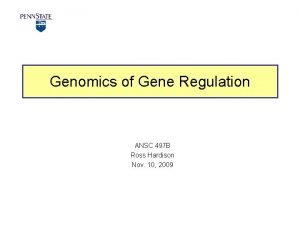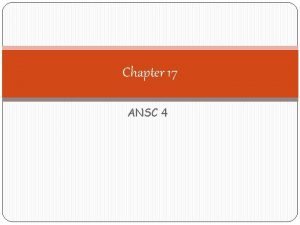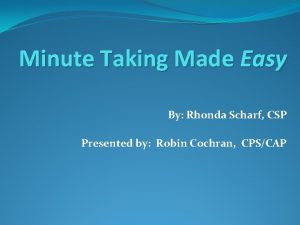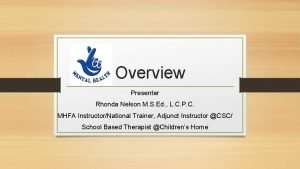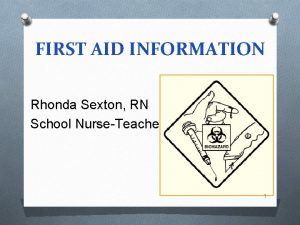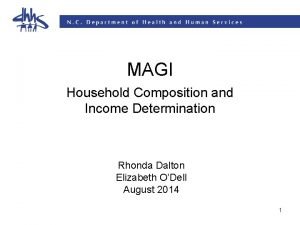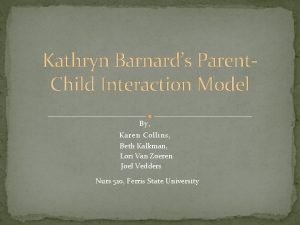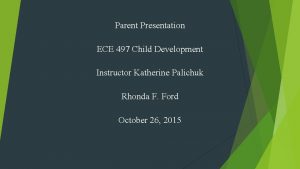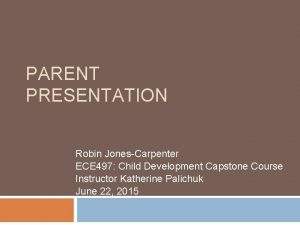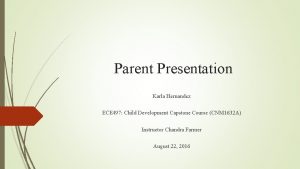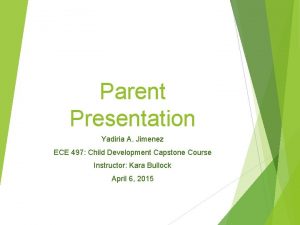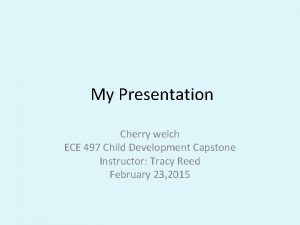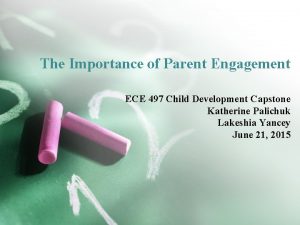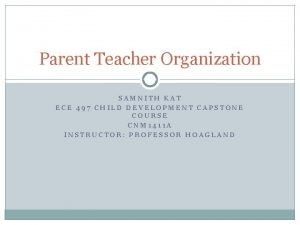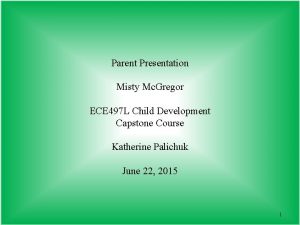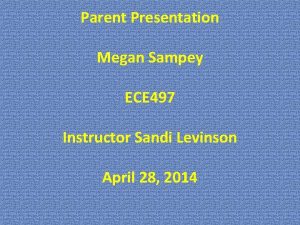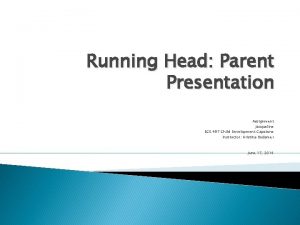Parent Presentation Rhonda Coleman ECE 497 Child Development
















- Slides: 16

Parent Presentation Rhonda Coleman ECE 497 - Child Development Capstone Course Instructor: Chandra Farmer November 16, 2016

My role as a Child Development Professional I also assist in the prevention and also responding to child neglect and abuse I work towards being knowledgeable in numerous family structures such as single parent, divorce, same sex and also grandchildren that live with their parents. I also consistently involve myself with parents to let them know the importance of their child as a professional. Finally, I let the parents know that I would work with their child to ensure that they succeed to their maximum potential.

Higley High School is located in Elmhurst, Illinois Higley High School is located in Anniston, Alabama It has 1500 students 9 th -12 th grade Composition 22% - Hispanic, 6% - Black, 5% - Asian, and 4% - American Indian. 22% of the students are eligible for free and/or reduced lunch 1% of the students are second language learners

Period of Development Elementary school age children They are : v Ages between 6 and 14 v Impressive and also are eager to learn v Working toward their next stage in life which is adulthood.

Rationale of Presentation Regardless of the age of the student, gender or their abilities, parental involvement in the education of the child is important. This presentation is based on the rationale of providing support for parents, the community and the school. Getting involved with the teacher during and after school hours will provide the parent the necessary satisfaction that their child is being taught and also learning what is needed (Olsen, 2010).

The Mesosystem (how families, schools, and the community are connected). Mesosystem involves the relationship that occurs between the microsystem manner of living of a person. The family life of an individual could spill into their school life. The academic progress of the child significantly depends on the activities they take part in within the classroom and also parental involvement in the school life of a child.

The Mesosystem (how families, schools, and the community are connected).

How important is cultural diversity in your community? Learn more about the history and culture of groups and not just your own. “Speak out against racist, homophobic, and sexist actions. Confront perpetrators of discriminating behavior, if you don't, you're sending the message that this behavior is acceptable” (Morgan).


Epstein’s types of Involvement Parenting: Necessary help all families need in the establishment of home environments that supports a child as a student. The child will develop respect for their parents especially when their parents become involved in their lives.

Epstein’s types of Involvement Communicating: Designing effective forms of school to home and also home to school communications programs involved in finding out more about the progress of the child. Communication done between the school and also home will allow the parents and also the child to know their progress and the areas they need to improve.

Epstein’s types of Involvement Volunteering: This includes recruitment and organizing parent assistance and support. Volunteering helps a child gain the opportunity of learning from numerous individuals (Epstein, n. d. ). This can be implemented through allowing parents to help in the classroom. Also for the younger students, a parent can also volunteer in reading a favorite story to the class. Parents can also be encouraged to participate in field trips and other special educational days in the classroom.

Epstein’s types of Involvement Learning at Home: This involves providing information and ideas towards families concerning how to assist students at home with their homework and also other curriculum related activities (Epstein, n. d. ). It encourages a child to finish their homework. The child will also acquire a positive attitude towards schoolwork. Also in this process, the parents must make it engaging for the children (Griffin, and Steen, 2010). This can be implemented through providing ideas for parents to help their children and giving homework tasks that will include involvement of family members.

Epstein’s types of Involvement Decision Making: This includes parents in school decisions, development of parent leaders and also representatives. The inclusion of parents in education decisions will teach the child that families have a voice and can make a difference in school decisions. This can be implemented through the encouragement of parent participation in PTO meetings.

Epstein’s types of Involvement Collaborating with Community: Involves identification and also the integration of resources and services from the community for the purpose of strengthening school programs, student learning, family practices and development (Epstein, n. d. ). Equipping the child with the chance of interacting with the community gives the child the opportunity of increasing their talents and skills. This can be achieved by including parents in the field that are associated with what the children are learning in class.

References Berk, L. E. (2013). Child development. (9 th ed. ). Upper Saddle River, NJ: Pearson. Griffin, D. , & Steen, S. (2010). School-Family-Community Partnerships: Applying Epstein's Theory of the Six Types of Involvement to School Counselor Practice. Professional School Counseling, 13(4), 218 -226. Epstein, J. (n. d. ). Epstein's framework of six types of involvement. Retrieved from http: //www. unicef. org/lac/Joyce_L. _Epstein_s_Framewor k_of_Six_Types_of_Involvement(2). pdf Epstein, J. (2010). School/Family/Community Partnerships: CARING FOR THE CHILDREN WE SHARE. (2010). Phi Delta Kappan, 92(3), 81. Olsen, G. (2010, July 20). The Benefits of Parent Involvement: What Research Has to Say. Retrieved from: http: //www. education. com/reference/article/benefitsparent-involvement-research/


